|
| Author |
 Topic Topic  |
|
roopakvaidya
|
 Posted -
26/11/2005
:
06:07 Posted -
26/11/2005
:
06:07
|
|
Cassini prepared for its rendezvous with Dione on Oct. 11, 2005, capturing the brilliant, cratered iceball in front of its shadow-draped planet.
http://photojournal.jpl.nasa.gov/jpeg/PIA07637.jpg
The terrain seen here becomes notably darker toward the west, and is crosscut by the bright, fresh canyons that form wispy markings on Dione's trailing hemisphere. Dione is 1,126 kilometers (700 miles) across.
The image was taken in visible light with the Cassini wide-angle camera at a distance of approximately 24,500 kilometers (15,200 miles) from Dione and at a Sun-Dione-spacecraft, or phase, angle of 22 degrees. The image scale is about 2 kilometers (1 mile) per pixel.
The Cassini-Huygens mission is a cooperative project of NASA, the European Space Agency and the Italian Space Agency. The Jet Propulsion Laboratory, a division of the California Institute of Technology in Pasadena, manages the mission for NASA's Science Mission Directorate, Washington, D.C. The Cassini orbiter and its two onboard cameras were designed, developed and assembled at JPL. The imaging operations center is based at the Space Science Institute in Boulder, Colo.
For more information about the Cassini-Huygens mission visit http://saturn.jpl.nasa.gov. The Cassini imaging team homepage is at http://ciclops.org
Roopak
|
|
| Author |
Replies |
|
roopakvaidya
|
 Posted - 19/03/2007 : 22:24 Posted - 19/03/2007 : 22:24
Earth, as seen from the vicinity of Saturn.
Picture taken by the spacecraft Cassini as it flies by Saturn.
Source: NASA

Edited by - roopakvaidya on 19 March 2007 22:26:53
Roopak  |
roopakvaidya
|
 Posted - 22/07/2007 : 22:17 Posted - 22/07/2007 : 22:17
A new moon has been discovered orbiting Saturn - bringing the planet's latest moon tally up to 60. The Cassini Imaging Team, who found the object, said Saturn's moon count could rise further still.
(From BBC News)
http://news.bbc.co.uk/2/hi/science/nature/6908190.stm
Roopak  |
roopakvaidya
|
 Posted - 12/03/2008 : 16:33 Posted - 12/03/2008 : 16:33
Cassini to make audacious flyby
Nasa has directed its Cassini spacecraft to pass just 50km from the 500km-wide Saturnian moon Enceladus on Wednesday.
BBC Article:
http://news.bbc.co.uk/2/hi/science/nature/7289670.stm
Roopak  |
|
|
Page load time - 0.422 |
|